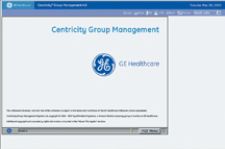
Centricity Practice Group Management by GE Healthcare provides revenue cycle management solutions that streamline and automate front-desk and back-office processes in the mid-sized group practice market.
New information technology (IT) systems come in three varieties: the leading edge that puts a group ahead of the adoption curve; the bleeding edge that requires a firm to accept a certain amount of pain with a new system; and the chainsaw edge, in which a practice risks getting chewed up by its technology choices.
Electronic medical record (EMR) implementations have earned the reputation as chainsaw-edge products, with some estimates holding that about one-third of the systems sold have resulted in de-installations. However, with the proper planning and process commitment, an EMR system can provide a practice with millions of dollars in savings, correct coding reimbursement and new revenue opportunities.
Julie Harper, director of Management Information Services for multispecialty practice Affinity Health Group of Tifton, GA, successfully spearheaded an EMR project at her facility through a combination of staged implementation, project benchmarks, and process re-engineering. She shared the details of Affinity's achievement at the Towards the Electronic Patient Record (TEPR) conference.
“We found out that no matter what module we rolled out, no matter how little or how large it was, it affected every department from the beginning to the end of (EMR) implementation,” she said.
Affinity Health’s specialties include radiology, cardiology, oncology, neurology and pulmonology, and is home to 27 physicians and seven midlevel providers at one main location and three satellite facilities providing its patients with primary care. With so many stakeholders in the practice, Harper built her EMR advisory team with representatives from each group, including a physician champion.
“We found that a physician champion, or lead physician, was very important to the success of the EMR,” she said. “He was able to relate to the workflow issues of another physician on a peer-to-peer basis.”
Another important element to the success of the EMR system at the group was the up-front realization that productivity would decrease by an expected 30 percent at the time of implementation. In light of this, the practice made an agreement to freeze its compensation plan for one year to support the technology integration and workflow retooling.
Harper runs a four-person IT department that was able to upgrade systems hardware, establish protocols, and assist in setting up inter-
faces among the EMR (TouchWorks 10.1.1, Allscripts, Chicago), practice management software (Centricity Group Management by GE Healthcare — formerly Groupcast 2.5, IDX Systems), and laboratory information system (Hex Laboratory Systems, Encinitas, CA). Although Affinity has two full-time radiologists, the practice does not yet have a PACS, but it is being considered for the future, according to Harper.
In 2003, Affinity began its phased introduction of the EMR implementation with Microsoft Windows 2000 training. By the end of 2004, the EMR system had been rolled out on a segment-by-segment basis about once every six weeks during the two-year period. This also included system upgrades to the IDX component as well as the EMR.
The group saw an initial 17 percent reduction in productivity in terms of office visits for the first month of implementation; this was trimmed to a two percent decrease a month later. Transcription use also decreased by 44 percent once the system was installed, Harper said.
Chart costs have also disappeared, resulting in $3,000 in savings for 417 patients over a seven-week period. The EMR system has simplified the registration process so Harper was able to decrease new patient registration by one employee. Call-processing capabilities have resulted in greater patient satisfaction by decreasing the response time for prescription refills and
medical complaints.
The EMR implementation has allowed the group to trim its staff of transcriptionists from seven to three, its medical records group from 10 to three, its front desk to one, and its collections team to five, providing a salaries and benefits savings of $202,000. Office expenses have also decreased by $60,000 annually, as the group was able to reduce its printing and copying needs with the EMR system. In addition, with the system being utilized at the point of care, physicians are now able to correctly code for each encounter, resulting in a net office charge revenue increase of 9.2 percent , or $2.5 million.
The cost of the EMR system is approximately $223,000 annually, resulting in a little over $2.5 million in annual EMR-based savings provided to the practice, Harper said.
The technology has also resulted in process improvements for Affinity, according to Harper. Its coding accuracy prior to EMR implementation was 76 percent, and it has risen to 93 percent after implementation. Accounts receivable has decreased by about five days on average, from 32 to 28 days. EMR adoption has also created new revenue opportunities for the practice as real estate freed up from medical record storage is now being considered for housing an open MRI system.
“We were glad that we were able to start moving on an EMR as early adopters because it has certainly had its financial gains and has really paid off,” Harper noted.
Jonathan S. Batchelor is an AuntMinnie.com staff writer.


 June 28, 2024
June 28, 2024 









